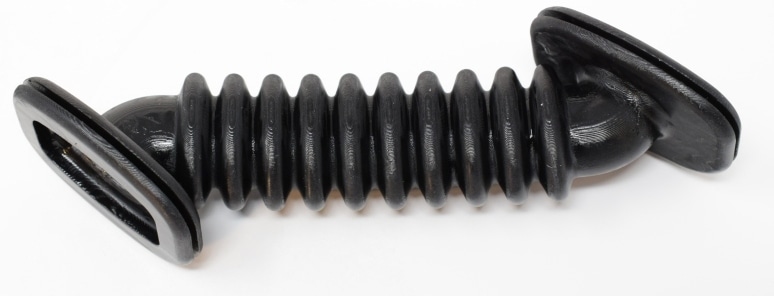Next week the company known for tough flexible additive manufacturing photopolymers, Adaptive3D, will introduce a high tear-strength direct curing rubber and polyurethane-like elastomer at FormNext in Frankfurt. Elastic ToughRubber™ 90 (ETR) is a photoresin designed for DLP™ based 3D printing of flexible end parts and products in the footwear, transportation, industrial and medical spaces.
 Figure 1. Car door boot printed from Elastic ToughRubber™ 90
Figure 1. Car door boot printed from Elastic ToughRubber™ 90
In the past, it has been challenging to additively manufacture elastomeric materials with rubber and polyurethane-like performance, especially those with sufficient strain capacity. Fused Filament Fabrication (FFF) and Selective Laser Sintering (SLS) of elastomeric thermoplastics result in properties and parts that are utilized primarily for prototyping. DLP and Sterolithography (SLA) printing require viscous materials with low elasticity, poor tear strength and small strains. Other DLP and SLA approaches require long and aggressive thermal post processes to form a secondary strong polymer network to displace the first printed, weaker network.
“Elastic ToughRubber™ 90 is a tough printable elastomer for all seasons,” said Adaptive3D CEO Walter Voit, PhD. He went on to say, “with stable performance at cold temperatures, a tear strength of 46 kN/m, greater than 200% elongation, and ease of processing, Elastic ToughRubber unlocks the benefits of 3d printing to those who manufacture and sell rubber, polyurethane and foam parts.”
Beyond its superior performance, ETR is optimized for the processing needs and quality requirements of a true manufacturing environment. The photopolymer resin is a one-part system that does not need mixing, which ensures higher part-to-part quality. It is also pot stable, meaning that leftover resin can be used in the following prints, which reduces expensive waste and overcomes the significant environmental challenges of other elastomeric polyurethane photopolymers.
“Elastic ToughRubber™ is not just designed for end parts and products, it is already proven, and it is being used today to manufacture and sell consumer products,” said VP Sales & Marketing Kial Gramley. “Ultimately, we believe that the shoe industry is the perfect place for this material and we are ready to scale up production in 2020.”
Parts made from Elastic ToughRubber™ will be displayed at Booth 12.1 G01 at FormNext in Frankfurt, Germany from November 19th -22nd.